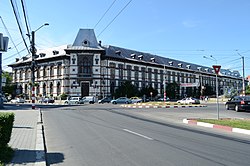Târgu Jiu
| Târgu Jiu | ||
|---|---|---|
| County capital | ||

Downtown
|
||
|
||
| Nickname(s): Brâncuși City (Romanian: Orașul lui Brâncuși) | ||
 Location of Târgu Jiu on Gorj County Map |
||
| Location of Târgu Jiu on Romania Map | ||
| Coordinates: 45°2′3″N 23°16′29″E / 45.03417°N 23.27472°ECoordinates: 45°2′3″N 23°16′29″E / 45.03417°N 23.27472°E | ||
| Country |
|
|
| County |
|
|
| Status | County capital | |
| Founded | 1406 (first official record as Jiul) | |
| Component localities | Bârsești, Drăgoieni, Iezureni, Polata, Preajba Mare, Romanești, Slobozia, Ursați | |
| Government | ||
| • Mayor | Florin Cârciumaru (Social Democratic Party) | |
| Area | ||
| • Total | 102 km2 (39 sq mi) | |
| Population (2011 census ) | ||
| • Total | 78,553 | |
| Time zone | EET (UTC+2) | |
| • Summer (DST) | EEST (UTC+3) | |
| Area code(s) | +40 x532 | |
| Car Plates | GJ-N3 | |
| Website | http://www.targujiu.ro/ | |
|
1 x, y, and z are digits that indicate the street, part of the street, or even the building of the address 2 x is a digit indicating the operator: 2 for the former national operator, Romtelecom, and 3 for the other ground telephone networks 3 used just on the plates of vehicles that operate only within the city limits (such as trolley buses, utility vehicles, ATVs, etc.) |
||
Târgu Jiu (Romanian pronunciation: [ˌtɨrɡu ˈʒiw]) is the capital of Gorj County in the Oltenia region of Romania. It is situated on the Southern Sub-Carpathians, on the banks of the river Jiu. Eight localities are administered by the city: Bârsești, Drăgoieni, Iezureni, Polata, Preajba Mare, Romanești, Slobozia and Ursați.
The city takes its name from the river Jiu, which runs through it. In antiquity, there was a Dacian village in around the location of today's city surrounded by forests. After the Roman conquests of Oltenia (101-102), military units were stationed around the roads that connected different important routes at the time. During the digging of the Târgu Jiu - Rovinari railroad, mosaics, coins, ceramics and Roman bricks were found in the south-eastern part of the city. This and ancient testimonies support the idea that Târgu Jiu was a commercial town (a vicus) while under the Roman Empire's rule. A very important route that connects the Danube to Transylvania runs through the city, so historians believe that part of the Roman Army under Trajan's leadership stayed and then passed in the actual location of the city.
After the 271 withdrawal of the Roman army, the city remained in the Latin influence zone, mainly because of Constantine The Great's involvement in Oltenia which he sought to bring under Imperial rule. The importance of keeping this zone under Rome's control was underlined by Constantine's decision to build a second bridge over the Danube between today's Corabia (then Sucidava) and the Bulgarian city of Gigen. It was over 2400 meters long, one of the longest of all time.
This territory was under Litovoi's rule, a Vlach (Romanian) voivode in the 13th century whose territory comprised northern Oltenia. He is mentioned for the first time in a diploma issued by king Béla IV of Hungary (1235–1270) on 2 July 1247. In 1277 (or between 1277 and 1280), Litovoi was at war with the Hungarians over lands king Ladislaus IV of Hungary (1272–1290) claimed for the crown, but for which Litovoi refused to pay tribute. Litovoi was killed in battle.
...
Wikipedia


